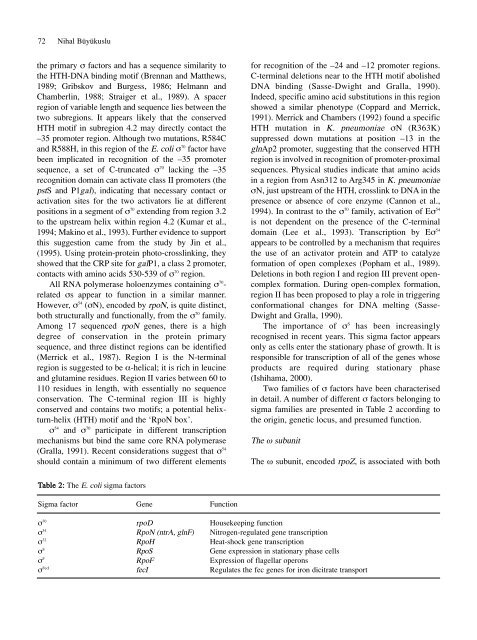(Converted)-5 - Journal of Cell and Molecular Biology - Haliç ...
(Converted)-5 - Journal of Cell and Molecular Biology - Haliç ...
(Converted)-5 - Journal of Cell and Molecular Biology - Haliç ...
Create successful ePaper yourself
Turn your PDF publications into a flip-book with our unique Google optimized e-Paper software.
72 Nihal Büyükuslu<br />
the primary σ factors <strong>and</strong> has a sequence similarity to<br />
the HTH-DNA binding motif (Brennan <strong>and</strong> Matthews,<br />
1989; Gribskov <strong>and</strong> Burgess, 1986; Helmann <strong>and</strong><br />
Chamberlin, 1988; Straiger et al., 1989). A spacer<br />
region <strong>of</strong> variable length <strong>and</strong> sequence lies between the<br />
two subregions. It appears likely that the conserved<br />
HTH motif in subregion 4.2 may directly contact the<br />
–35 promoter region. Although two mutations, R584C<br />
<strong>and</strong> R588H, in this region <strong>of</strong> the E. coli σ 70 factor have<br />
been implicated in recognition <strong>of</strong> the –35 promoter<br />
sequence, a set <strong>of</strong> C-truncated σ 70 lacking the –35<br />
recognition domain can activate class II promoters (the<br />
pstS <strong>and</strong> P1gal), indicating that necessary contact or<br />
activation sites for the two activators lie at different<br />
positions in a segment <strong>of</strong> σ 70 extending from region 3.2<br />
to the upstream helix within region 4.2 (Kumar et al.,<br />
1994; Makino et al., 1993). Further evidence to support<br />
this suggestion came from the study by Jin et al.,<br />
(1995). Using protein-protein photo-crosslinking, they<br />
showed that the CRP site for galP1, a class 2 promoter,<br />
contacts with amino acids 530-539 <strong>of</strong> σ 70 region.<br />
All RNA polymerase holoenzymes containing σ 70 -<br />
related σs appear to function in a similar manner.<br />
However, σ 54 (σN), encoded by rpoN, is quite distinct,<br />
both structurally <strong>and</strong> functionally, from the σ 70 family.<br />
Among 17 sequenced rpoN genes, there is a high<br />
degree <strong>of</strong> conservation in the protein primary<br />
sequence, <strong>and</strong> three distinct regions can be identified<br />
(Merrick et al., 1987). Region I is the N-terminal<br />
region is suggested to be α-helical; it is rich in leucine<br />
<strong>and</strong> glutamine residues. Region II varies between 60 to<br />
110 residues in length, with essentially no sequence<br />
conservation. The C-terminal region III is highly<br />
conserved <strong>and</strong> contains two motifs; a potential helixturn-helix<br />
(HTH) motif <strong>and</strong> the ‘RpoN box’.<br />
σ 54 <strong>and</strong> σ 70 participate in different transcription<br />
mechanisms but bind the same core RNA polymerase<br />
(Gralla, 1991). Recent considerations suggest that σ 54<br />
should contain a minimum <strong>of</strong> two different elements<br />
Table 2: The E. coli sigma factors<br />
Sigma factor Gene Function<br />
for recognition <strong>of</strong> the –24 <strong>and</strong> –12 promoter regions.<br />
C-terminal deletions near to the HTH motif abolished<br />
DNA binding (Sasse-Dwight <strong>and</strong> Gralla, 1990).<br />
Indeed, specific amino acid substitutions in this region<br />
showed a similar phenotype (Coppard <strong>and</strong> Merrick,<br />
1991). Merrick <strong>and</strong> Chambers (1992) found a specific<br />
HTH mutation in K. pneumoniae σN (R363K)<br />
suppressed down mutations at position –13 in the<br />
glnAp2 promoter, suggesting that the conserved HTH<br />
region is involved in recognition <strong>of</strong> promoter-proximal<br />
sequences. Physical studies indicate that amino acids<br />
in a region from Asn312 to Arg345 in K. pneumoniae<br />
σN, just upstream <strong>of</strong> the HTH, crosslink to DNA in the<br />
presence or absence <strong>of</strong> core enzyme (Cannon et al.,<br />
1994). In contrast to the σ 70 family, activation <strong>of</strong> Eσ 54<br />
is not dependent on the presence <strong>of</strong> the C-terminal<br />
domain (Lee et al., 1993). Transcription by Eσ 54<br />
appears to be controlled by a mechanism that requires<br />
the use <strong>of</strong> an activator protein <strong>and</strong> ATP to catalyze<br />
formation <strong>of</strong> open complexes (Popham et al., 1989).<br />
Deletions in both region I <strong>and</strong> region III prevent opencomplex<br />
formation. During open-complex formation,<br />
region II has been proposed to play a role in triggering<br />
conformational changes for DNA melting (Sasse-<br />
Dwight <strong>and</strong> Gralla, 1990).<br />
The importance <strong>of</strong> σ S has been increasingly<br />
recognised in recent years. This sigma factor appears<br />
only as cells enter the stationary phase <strong>of</strong> growth. It is<br />
responsible for transcription <strong>of</strong> all <strong>of</strong> the genes whose<br />
products are required during stationary phase<br />
(Ishihama, 2000).<br />
Two families <strong>of</strong> σ factors have been characterised<br />
in detail. A number <strong>of</strong> different σ factors belonging to<br />
sigma families are presented in Table 2 according to<br />
the origin, genetic locus, <strong>and</strong> presumed function.<br />
The ω subunit<br />
The ω subunit, encoded rpoZ, is associated with both<br />
σ 70 rpoD Housekeeping function<br />
σ 54 RpoN (ntrA, glnF) Nitrogen-regulated gene transcription<br />
σ 32 RpoH Heat-shock gene transcription<br />
σ S RpoS Gene expression in stationary phase cells<br />
σ F RpoF Expression <strong>of</strong> flagellar operons<br />
σ FecI fecI Regulates the fec genes for iron dicitrate transport

















